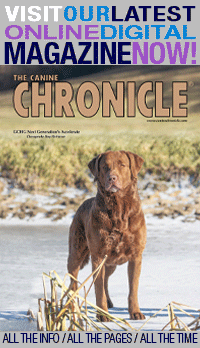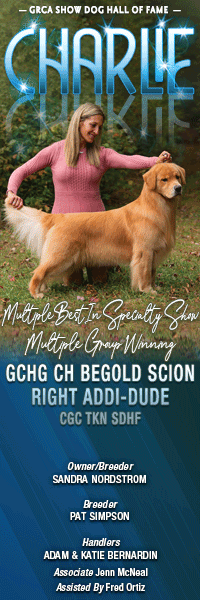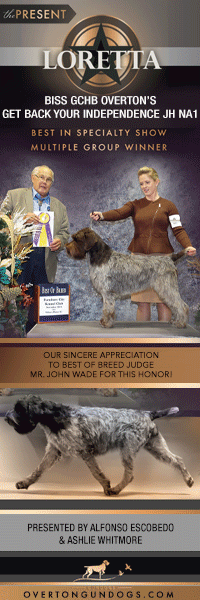Having Your Cake and Eating It Too!
226 – October, 2010
by Chris Robinson

- Crosby (Ch. Quicksilver’s Rhythm & Blues RN RD) was sent by his California owners to Strupp in Montana to learn how to be a road dog at the age of 10. In two months he was ready to not only pass the DCA’s road dog test but to do it in the traditional way with a vehicle, and a mule-drawn one at that.
Horses and dogs just naturally seem to go together. When I was riding jumpers and galloping racehorses, there were always dogs around the stables and at the boarding facilities. The horse owners almost always brought their dogs along when they came to ride. Horse people just seem to love dogs and many dog owners feel the same way about horses. However, other than Foxhounds and Harriers, nowhere in the dog world is this mutual love affair more apparent than with Dalmatian owners who give their dogs the opportunity to do what the breed was intended to do.
“Having the dogs along on a ride doing their real job is like riding in a ‘66 Mustang convertible with the top down. You love what you are doing and you know everyone wants to be you. Having a Dalmatian as a trail companion is both comforting and rewarding. On the one hand, it’s so nice to be able to share the forest with my best friend and see the enjoyment he gets from the sights, sounds and smells. On the other hand, it is a breathtaking sight to see the dog fall into his natural gait, matching strides with the horse and sharing a relationship with an animal that’s ten times bigger. It’s like watching a beautiful sunset and riding in a jazzy sports car all in one,” said Peggy Strupp who often shares a trail with either of her Dals, Ch. Koira Redrk Radagast the Brown RN CD RD RDX or Ch. Redrock’s Harmonyc Cadence CD CC RD RDX.
The fact that Dals and horses seem to belong together is not surprising with a breed that for roughly 300 years, before the automobile replaced horses as the principal means of transportation, was the original and only coaching dog. Dalmatians were able to run great distances without tiring and they had a natural calming effect on horses. Once this trait was recognized, mounted warriors or hunters began to use Dals in their activities. Starting in the 17th century, Dalmatians became a “society dog” and were trained to run alongside the ladies’ carriages. They were also used to protect the horses that pulled English stagecoaches. Two would run next to the horses as they pulled a coach and when other dogs ran out to scare the horses, the Dalmatian would chase them away.
During the era of the horse-drawn fire engines, the breed developed its strong tie to firemen. Since firehouse horses had to spend hours at fire scenes or days at the fire hall waiting for a call, the firemen needed something to keep the horses calm. Contrary to popular belief, fire horses were not broken down old nags but rather fine, high-spirited animals. Once at the scene of the fire, the Dalmatian became the guard dog making sure none of the firemen’s equipment was stolen. The tradition of a Dalmatian in the firehouse continues even though the horses are gone. Now the dogs guard the fire truck.
Although the historical background of the breed says Dalmatians and horses belong together, both parties to this partnership require some training to make it work. Obedience, speed and stamina were necessary for a Dalmatian to be a coach dog and these are still required in the Dalmatian Club of America’s road trial program.
“Most Dals will stay with a horse and rider without much encouragement,” said Janey Randlett, who owns five Dals that are both champions and have a road title including Ch. Bottoms Up I Wonder RD that was the top Dalmatian female during her show career.
“However, they do require a bit of ‘fine tuning’ for a formal trial. Each dog is an individual and handles differently. I wait until my young dogs tell me they are ready to settle down and work. I don’t force the issue. Some are more suited to the job than others. I’ve discovered there are several ‘styles’ of coaching. Some will stay behind the horse, others on one side and a few are what I call circlers. They range a short distance in front and then automatically return to the horse and rider. I suspect that these dogs descend from the fire house dogs which would clear a path for the horses on the way to a fire. The most important aspect of training a Dal for road work is that you have total leash control on the ground before you start with a horse.”
“Because it is obedience work from horseback, the training varies with each dog,” said Sara Pruyne, whose current Dalmatian, CT Ch. PatchMtn C Pepper N Paisley RE OA OAJ NAP NJP NF RD CPC PAC Can TDX AG AGNJ is both a conformation champion and a champion tracker. “When I first started doing road work, I had two Dals that had a CDX but also had completely different attitudes. Windy was great with the horse but her attitude about obedience was that she would do things in her own good time. Crystal always wanted to be near me and the horse made it more fun. Carina, my current Dal, usually considers obedience to be beneath her but she loves working with the horse. As a result, she understood within a few lessons where exactly to be when the horse was trotting or cantering. With her, working with the horse just did develop naturally.”
Strupp, who chairs the road dog program committee for the Dalmatian Club of America, agreed that the basic instincts are generally still “there” in most Dalmatians. “All the dogs I have trained for the DCA’s road tests had an instinct for coaching even if I had to ‘unearth’ it. Some Dals just have a ‘need’ to follow a moving horse and quickly build a relationship of trust with the horse. But, you can’t take a Dal out on the road on just instinct. The days of quiet, uninterrupted carriage driving down a country lane are pretty much gone in America. Most trail time with a Dalmatian involves negotiating traffic, crossing roads, meeting wildlife and meeting other, off-leash dogs. The Dalmatian that is a coaching companion in the modern world must be unfailingly obedient to basic commands. Even the Dalmatian with a lot of instinct will need ground training in basic obedience to keep him safe on the road.”
Still, it takes a certain type of “dog personality” to be a successful road dog. “Dalmatians do not ‘think’ like most popular breeds do. While most working breeds look to their owner/trainer for direction, a Dalmatian is expected to solve a situation for himself. Just as an example, you are riding or driving a carriage and your dog is with you. Something spooks the horse and you have your hands full just regaining control. You don’t have time to tell the dog what sort of help you need such as protect you from another dog or animal. The dog must solve the situation for himself. So, over the years, we have developed a dog that is an independent thinker. I’ve found it helps a lot to have a sense of humor when you are training them,” said Randlett.
“You can’t be a cheerleader from horseback,” said Pruyne. “For that reason, a ‘soft’ Dal would not be one that I would consider a good prospect for road work. The dog has to be self-confident and outgoing to do the training and distance work needed to be a good road dog. You have to have a dog that is willing to mind you when you are ‘way up there’ and that takes work. It is also necessary to work on obedience in the real environment. If you can’t call them off wildlife on a normal trail ride, you don’t have a prayer of doing that in the stress of a road test. I’ve found that during practice sessions, I frequently have to get on and off the horse to correct the dogs more than I just get to ride.”
Strupp said that in her opinion, most Dals that show no interest in road work are simply distracted by the off-leash freedom or are cautious of getting near such a large animal. “Simple obedience training teaches the dog to stay close to the handler. The dog soon learns that following a handler on horseback is a lot of fun and we all know that Dalmatians love to have fun! However, it is important to ‘proof’ them before running them in a road trial. Even dogs with a lot of instinct for this work can get temporarily distracted by a great outdoor smell and this can cause them to non-qualify at a road trial. Distractibility also means the dog is at a greater risk for injury. Some exhibitors do not seem to understand basic obedience well enough to know how to ‘proof’ their dogs. In a road trial, there is a distraction situation so a dog should be well-trained and ‘proofed’ or tested with distractions before they are taken out and allowed to run off leash on any trail ride. This is just a common sense safety factor but many people skip this step.”
However, the dogs are not the only part of the partnership that needs some training. Horse temperament also has to be considered. “Temperament is very important when choosing a trail horse,” said Strupp. “Some horses hate dogs and these would be a poor choice for a road dog companion. But, most horses that have a good temperament will be tolerant of the dogs. My horses have formed a bond with the Dals and seem to enjoy their companionship at the barn or on the trail.”
Road titles are growing in importance among Dalmatian people. “If my dogs can’t do what they were intended to do what is the point of breeding or showing?” said Randlett. “There are a lot of different breeds, each with a ‘job.’ In a way, that job or purpose defined the breed. So, whether or not you ever are able to compete in a road trial, at least keeping the purpose for which the breed was intended in mind when you are breeding should help produce a dog that is sound in structure and has a sound mind as well.”
“I think the road titles have been beneficial to the breed because these titles are earned by dogs that are good tempered—they can work in strange places with a variety of dogs and distractions—and are structurally sound. A poorly built dog will just not hold up to this kind of work. Straight shoulders, flat feet, weak pasterns, cow hocks and other conformation flaws I see in the breed won’t be able to withstand the demands of this kind of work. Those conformation judges who put up structurally poor dogs in the show ring based on markings or who is handling the dog are not doing the breed any favors. Dogs with these conformation flaws should not be winning at ANY level,” said Pruyne.
“The road dog program has been great for the breed and Dalmatian people have embraced the sport, both financially and emotionally. Everyone loves to see a dog doing what it was bred to do and Dalmatians, being quite photogenic themselves, get to ‘do their thing’ with another beautiful, majestic animal. The breed has benefitted greatly from the revival of road trials and from the support for this program that has been provided by the DCA,” said Strupp.
Short URL: https://caninechronicle.com/?p=1583
Comments are closed















